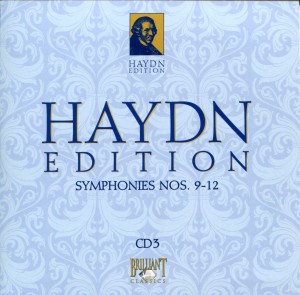 This morning’s listening fare opened with a bang — like thoroughbreds out of the gate.
This morning’s listening fare opened with a bang — like thoroughbreds out of the gate.
And it should. The first composition on CD 3 is Symphony No. 9 in C, the first movement of which is allegro molto — very quick.
Which is a terrific way to begin a day.
Symphony 9 in C is a short symphony – its three movements constitute only about 12 minutes in length – that seems to end much too quickly. No sooner are the horses out of the gate and sprinting down the track when the race is over, and I find myself in Symphony No. 10 in D.
In between, however, is Movement II (“Andante”), which — as the term suggests — is slower, literally “at a walking pace.” It gives my metaphorical horses a chance to catch their breath.
Movement III (“Finale: Menuetto & Trio”) is slow, graceful, in the tempo of a minuet (often in 3/4 or 6/8 time). So now the horses are high stepping to show off a bit.
Symphony No. 9 in C was written in 1762 when Haydn was 30 years old.
Symphony No. 10 in D opens with an allegro movement featuring lots of sweeping stringed instruments and that majestic, triumphant quality that always makes me want to do something heroic. It’s second movement (“Andante”) seems to drag a bit, retarding a bit the wonderful feeling I got from Movement I. But Movement III (“Finale: Presto”) redeems Symphony No. 10 in my book. I like my movements to be quick, not relying too much on the maudlin andante tempos, which tend to cause my mind to wander. Movement III does the trick nicely, jumping, skipping, bouncing, and sing-songing its way through 3:16 of pure joyful abandon.
There is debate regarding when Symphony No. 10 in D was written. No earlier than 1757 and no later than 1761. So Haydn was as young as 25 or as old as 29.
Symphony No. 11 in E Flat is, to me, a bland composition. It opens too slowly (“adagio cantabile” — “slow and stately”) to grab me by the lapels and pull me in. By the time the much-preferred Movement II (“allegro”) arrives, I’ve already lost interest. “Ya got one chance, Franz! Grab me by the lapels or I’m outta here!” (Yeah, right. Like he’d care what I thought.)
According to its entry on Wikipedia, Symphony No. 11 in E Flat “may have been written as early as 1760 but no later than 1762.” That means Haydn was 28 to 30 years old.
The last of the four symphonies on CD 3 is Symphony No. 12 in E, written in 1763 when Haydn was 31. It has a pleasant construction, with instruments that weave nicely too and fro. Yet, it doesn’t grip me the way Symphony No. 9 did. It’s a competent symphony, certainly better than one I could write. But it’s not my favorite on CD 3.

I definitely prefer an Allegro to an Adagio. Your line about Symphony 12 made me chuckle. It’s a good symphony, but not a great symphony…and then Haydn punched me in the mouth.